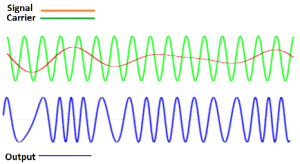Frequency Modulation
Frequency modulation is a method of impressing data onto an alternating – current wave by varying the instantaneous frequency of the wave. This can be used with Analog or Digital data. In Analog Frequency Modulation, the frequency of the Alternating Current signal waves, also called the Carrier varies in a continuous manner.
In Digital Frequency Modulation, the carrier frequency shifts abruptly, rather than varying continuously. The number of possible carrier frequency states is usually a power of 2. If there are only two possible frequency states, the mode is called frequency – shift – keying.
What is Frequency Modulation?
Frequency modulation involves superimposing on the high frequency carrier wave, baseband signal i.e., if the amplitude of the baseband increases, there is an increase in the wavelength meaning a drop in the frequency of the carrier wave and vice versa. The amount by which the signal frequency varies is a very important factor since this is what decides the quality of the signal sent by the FM transmitter. This variation is known as deviation and is normally quoted in terms of KHz.

In order for the frequency modulated signal to be meaningful to the receiver, the signal first has to interpret and then the frequency variation should be smoothened to obtain just the baseband signal. This is done by an equipment called the Demodulator. The output at the demodulator provides the information carried and transmitted by the FM wave. As an example the signal may have a deviation of ±3 kHz. In this case the carrier is made to move up and down by 3 kHz.
